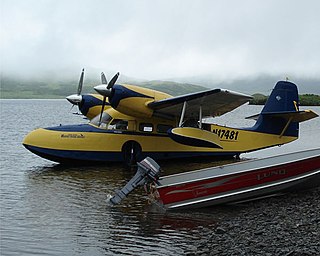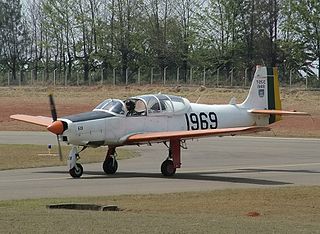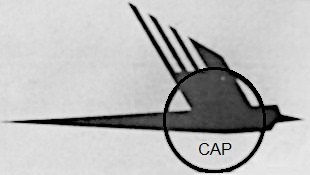
The Cessna O-1 Bird Dog is a liaison and observation aircraft that first flew on December 14, 1949, and entered service in 1950 as the L-19 in the Korean War. It went to serve in many branches of the U.S. Armed Forces, was not retired until the 1970s in a number of variants, and also served in the Vietnam War. It was also called the OE-1 and OE-2 in Navy service, flying with the Marine Corps, and in the 1960s it was re-designated the O-1. It remains a civilian-flown warbird aircraft, and there are examples in aviation museums. It was the first all-metal fixed-wing aircraft ordered for and by the United States Army following the Army Air Forces' separation from it in 1947. The Bird Dog had a lengthy career in the U.S. military as well as in other countries, with over 3400 produced.

The Grumman G-44 Widgeon is a small, five-person, twin-engined, amphibious aircraft. It was designated J4F by the United States Navy and Coast Guard and OA-14 by the United States Army Air Corps and United States Army Air Forces.

The Embraer EMB 110 Bandeirante is a Brazilian twin-turboprop light transport aircraft designed by Embraer for military and civil use.

The Embraer EMB 121 Xingu is a twin-turboprop fixed-wing aircraft built by the Brazilian aircraft manufacturer, Embraer. The design is based on the EMB 110 Bandeirante, using its wing and engine design merged with an all-new fuselage. The EMB 121 first flew on 10 October 1976.

In a fixed-wing aircraft, the spar is often the main structural member of the wing, running spanwise at right angles to the fuselage. The spar carries flight loads and the weight of the wings while on the ground. Other structural and forming members such as ribs may be attached to the spar or spars, with stressed skin construction also sharing the loads where it is used. There may be more than one spar in a wing or none at all. Where a single spar carries most of the force, it is known as the main spar.

The Embraer EMB 202 Ipanema is a Brazilian agricultural aircraft used for aerial application, particularly crop dusting. It is produced by Indústria Aeronáutica Neiva, a subsidiary of Embraer located in Botucatu, Brazil. The latest version of this aircraft is the first ethanol-powered fixed-wing aircraft, which could give it an economical advantage over the gasoline version. The aircraft is widely employed in Brazil, having market share of about 80%, and the 1,000th delivery was completed on 15 March 2005. Besides aircraft, alcohol-conversion kits for gasoline-powered Ipanemas are also sold.

The Embraer EMB 312 Tucano is a low-wing, tandem-seat, single-turboprop, basic trainer and counter-insurgency aircraft developed and produced by Embraer in Brazil. The Brazilian Air Force sponsored the EMB-312 project at the end of 1978. Design and development work began in 1979 on a low-cost, relatively simple, new basic trainer with innovative features which eventually became the international standard for basic training aircraft. The prototype first flew in 1980, and initial production units were delivered in 1983.

The Neiva N621 Universal is a Brazilian propeller-driven basic trainer and ground attack aircraft manufactured by Indústria Aeronáutica Neiva. It is a cantilever, low-wing monoplane of all-metal construction, with retractable undercarriage and side-by-side seating.
The CAP-1 Planalto was a military trainer aircraft built in Brazil during World War II. It was a low-wing cantilever monoplane with fixed tailwheel undercarriage that accommodated the pilot and instructor in tandem open cockpits. The project had been initiated by Instituto de Pesquisas Tecnológicas (IPT) under the designation IPT-4 and although the design work had been contracted to CAP, IPT insisted on a wing profile of its own choosing that led to serious stability problems in the final product.

The CAP-4 Paulistinha was a military and civilian trainer aircraft built in Brazil during the 1930s and 1940s.

Companhia Aeronáutica Paulista usually known as CAP was a Brazilian aircraft manufacturer established in São Paulo.

The Mudry CAP 10 is a two-seat training aerobatic aircraft first built in 1970 and still in production in 2007. The plane was developed from the Piel Super Emeraude and was born as the CP100. The name changed to CAP 10, CAP for 'Constructions Aéronautiques Parisiennes'. The CAP 10 was manufactured by Mudry in Bernay, France, bought by CAP Industries which then became Apex Aircraft. Following the bankruptcy of Apex in 2008, rights to produce spares were awarded to Dyn'Aviation. After the bankruptcy of DynAero in 2012, manufacture of spares was taken over by CEAPR in Darois.

The Mudry CAP 20 is a French family of aerobatic competition single seater monoplanes.

The Curtiss Fledgling, known internally to Curtiss as the Model 48 and Model 51 is a trainer aircraft developed for the United States Navy in the late 1920s and known in that service as the N2C.

The PZL-102 Kos (blackbird) is a Polish two-seat touring and training monoplane designed and built by PZL.

The Macchi M.5 was an Italian single-seat fighter flying boat designed and built by Nieuport-Macchi at Varese. It was extremely manoeuvrable and agile and matched the land-based aircraft it had to fight.

The Macchi M.7 was an Italian single-seat fighter flying boat designed by Alessandro Tonini and built by Macchi. A modified version of the M.7, the M.7bis won the Schneider Trophy in 1921.

The Macchi M.9 was a flying boat bomber designed by Alessandro Tonini and produced by Macchi in Italy close to the end of World War I and shortly afterwards.

The Morane-Saulnier MS.129 and its derivatives in the MS.130 series were a family of military trainer aircraft produced in France in the 1920s.
Aeromot Aeronaves e Motores S.A is a Brazilian industrial group that markets aeronautical products. It was responsible for the aeronautical system of the World Cup 2014 and the 2016 Summer Olympics. The company is based at Salgado Filho Airport, Porto Alegre capital of Rio Grande do Sul, was founded in July 1967, and also has a branch located at Pampulha airport, Belo Horizonte.

















